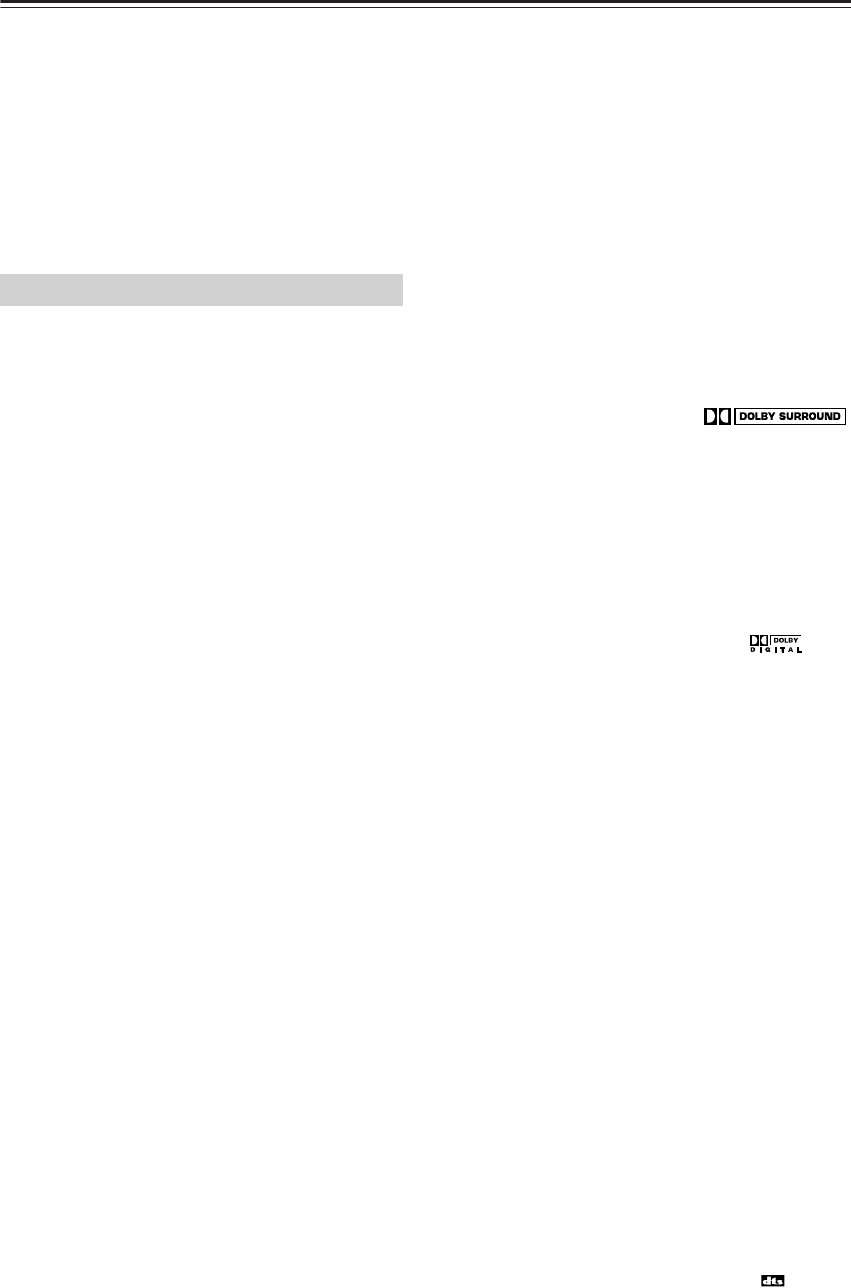
44
Using the Listening Modes
The DTR-7.4’s surround sound enables you to enjoy
movie theater or concert hall quality sound in your
home.
The configuration of the speakers is very important for
the surround sound effect. Refer to “About Home
Theater” on page 16.
Before selecting a listening mode, be sure to complete
the Speaker Setup (See page 32). Once the parameters
have been set, it is not necessary to set them again. See
pages 44-45 for information regarding how to select the
listening mode.
Mono
This mode is for playing old movies where the sound is
recorded in monaural or for playing the left and right
channels separately for movies that contain different lan-
guage signals. This mode also allows you to listen to the
multiplexed soundtracks on DVDs and other media that
have them.
Pure Audio
The same as the direct mode except that the pure audio
mode also turns off the display window, turns off the
power supply to the video circuitry (resulting in a
blacked-out screen), and minimizes the sources of noise.
The result is high-fidelity music playback true to the
original source.
Direct
This mode delivers pure sound with minimal sound qual-
ity adjustment and filtration. The sound recorded for the
right and left front channels is output to the right and left
front speakers only and not output to the subwoofer.
Stereo
All input sound is output from the left and right front
speakers.
The subwoofer is also used for playback.
T-D (Theater-Dimensional)
For the best enjoyment of your home theater, it is recom-
mended that you have front left and right speakers, a cen-
ter speaker, and surround left and right speakers.
However, if you only have front left and right speakers,
you can enjoy multichannel audio by using this mode.
This mode controls the characteristics of the sound that
reaches each ear to reproduce a multi-speaker setup. To
receive the full effect, there is an optimum listening posi-
tion (sweet spot). Refer to the explanation of the listen-
ing angle. In addition, if the reflective sound components
are large, it may be difficult to achieve the desired result,
so be sure to set up your system and listening position to
minimize reflective sound.
Dolby Pro Logic II
As opposed to Dolby Pro Logic, which had four chan-
nels (front left/right, center, and surround) recorded into
two channels with matrix processing and then played
back in four channels, Dolby Pro Logic II uses a feed-
back logic circuit to have 5.1 channel surround audio
(Dolby Surround, etc.) matrix-encoded into two chan-
nels and then played back in its original 5.1 channel
form.
Dolby Pro Logic II provides a Movie Mode designed for
playing movies and a Music Mode designed for listening
to music.
In the Movie Mode, the surround channels, which used
to provide monaural output over only a narrow fre-
quency range, now provide complete stereo output over
the full frequency range. The result is movie viewing
with a realistic feel of movement. This mode can be used
with VHS and DVD videos with the
mark and certain television programs.
The Music Mode uses the surround channels to provide
a natural soundfield that cannot be provided with normal
stereo output. This mode can be used with music com-
pact discs and other stereo sources.
Dolby D (Dolby Digital)
This mode is used for playing Dolby Digital sources.
Dolby Digital is compressed digital data with a maxi-
mum of 5.1 channel surround sound. This source signal
comes from DVDs and LDs that have the mark
and therefore are recorded for 5.1 channel output.
• Dolby Digital EX
Enabled when playing back sources with surround tracks
that were encoded using the Surround EX technology.
DTS Neo:6
This mode is for 6.1 channel playback of sources such as
PCM or analog sources that have only two channels. The
outputs of all six channels have a wide frequency range
with a great separation between the different channels.
This mode can be set to the Cinema Mode designed for
playing movies and the Music Mode designed for listen-
ing to music.
The Cinema Mode is good for movies. The reproduced
surround sound provide the same realistic feel of move-
ment as 6.1 channel sources. This mode can be used with
VHS and television programs with stereo sound.
The Music Mode uses the surround channels to provide
a natural sound space that cannot be provided with nor-
mal stereo output. This mode can be used with music
CDs and other stereo sources.
DTS
This mode is used for playing DTS sources.
DTS (Digital Theater System) is compressed digital data
with a maximum 5.1 channel surround output (6.1 channel
with DTS-ES Discrete sources) that allows for an
extremely high-quality sound. This source signal requires a
DVD player that supports DTS output and comes from
DVDs, compact discs, and LDs that have the mark.
Listening Modes


















